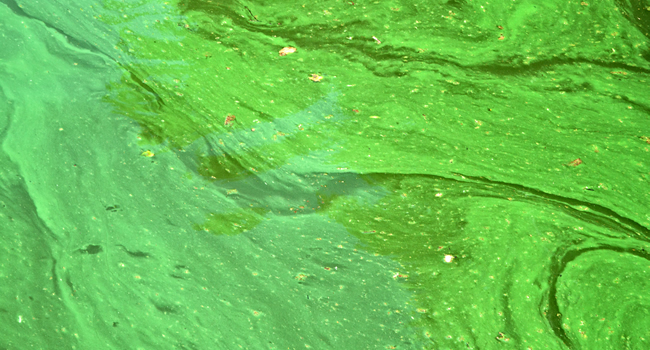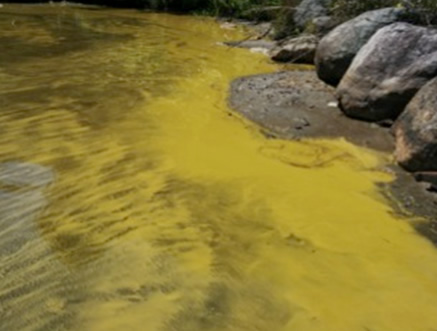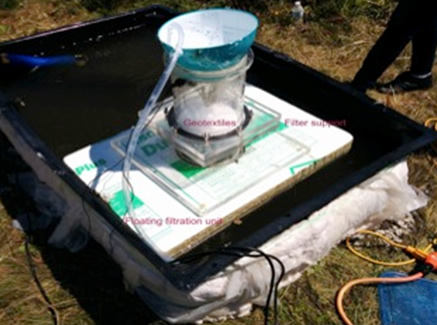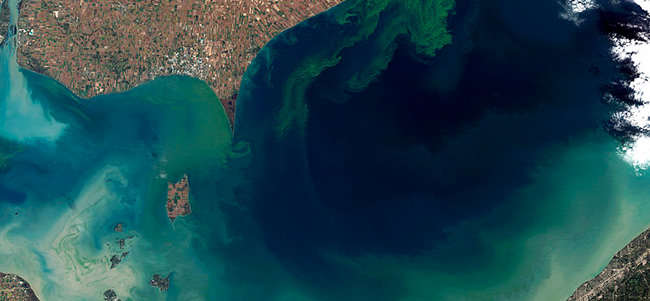Can nonwoven geotextiles prevent the suffocating damage of eutrophication in waterways? That is a question Titan Environmental Containment‘s Sam Bhat, M. Eng., is helping answer in a collaborative project with environmental engineering professor Catherine Milligan and Concordia University (Canada).
An NSERC Collaborative Research and Development Grant has been awarded for 2017-19 for the team’s research project, “Improvement in Surface Water Quality Using Geotextiles.”

Results from a previous NSERC engagement plus additional investigations will be presented during the Canadian Society for Civil Engineering conference 31 May – 3 June 2017 in Vancouver.
“Very limited work has been done to remediate surface water by using geotextiles as filter media,” Milligan wrote in a 2016 paper co-authored with Titan’s Sam Bhat and Milligan’s Concordia University colleagues Shrabani Sarma, Keoponnreay Kim, Dileep Palakkeel Veetil, and Prof Catherine Mulligan.
During the 2017 conference, the team will present updated research, which has involved three different custom geotextiles on a eutrophic lake 75 km north of Montreal in the town of Saint-Anne Des Lacs, Quebec.

COMBATTING EUTROPHICATION WITH GEOTEXTILES
Lake Caron, the site of the geotextiles and eutrophication research, is an artificial lake with a surface area of 35,300 m2. No waterways feed into it, making its only sources of water immediate area runoff, precipitation, and snow melt. Though much of the lake is surrounded by trees, private land application of fertilizer, use of phosphate detergents, septic tank discharges, and shoreline erosion have caused phosphorous loading in the water. Runoff from the forest lands has also contributed to elevated phosphorus concentration, which in some areas varies from 908 – 1310 mg/kg. Excessive plant growth and algal blooms have occurred in the shallow water. The depth is only 2.6m. The result—eutrophication—has led to decomposition and death in the water as oxygen levels have been depleted.
In setting up the shoreline experiment, which was cited in an area more prone to algal bloom, the research team set up plastic tanks (35.6 cm height and 543 L volume) and placed them on ground leveled with gravels near the shore. The filtration units consisted of cylindrical filtration columns made of plexiglass. The columns had a 20-cm internal diameter and a height of 25 cm. The square-shaped base, as a filter holder, had a circular hole at the center with the exact diameter of the filtration column (20 cm).

Over a three-month period, a wide-range of turbidity levels were tested (10.4 – 32.4 NTU) along with different arrangements of the custom nonwoven geotextiles, which featured pore size filter characteristics 75 – 110 μm. The geotextiles were custom-made for the study’s evaluation of nutrient and suspended solids removal efficiency.
The results have been intriguing.
“A significant reduction in turbidity was observed when the number of filters with small opening sizes (75 and 90 µm) was increased,” the team writes in its most recent research. “Using more filters with a smaller pore size could capture more solids and minimize carryover of undersized particles through the filters. However, these kinds of filter combinations are susceptible to fast clogging. Filters with a large opening size (110 µm) were less liable to clogging. However they were not very effective towards fine particle capture…. The test results from this study have shown that non-woven geotextile filters can be used for improving surface water quality. The geotextile filters resulted in the removal of 85 – 98% turbidity, 59 – 82% TP, 67 – 89% chlorophyll a, 78 – 93% BGA-PC and 33 – 66% COD depending on the initial water quality.”
A FUTURE WITH BETTER WATER QUALITY
While nonwoven geotextiles are widely used for environmental and civil engineering applications, Titan Environmental developed custom geotextiles for the Lake Caron investigation due to the uniqueness of the study. The proximity of Titan’s manufacturing site to the project also helped the decision to customize in the search for geotextiles that could combat eutrophication.
Customization also helped address some of the great challenges of this type of research, such as:
- Designing filters with correct pore sizes and other mechanical and hydraulic properties to cope with the actual site conditions
- Designing and fabricating filtration systems that can be effective in the actual lake conditions
- Formulating the filter’s mechanical and hydraulic properties with the ability to accommodate the variations between lab and field-scale filter outputs
- Increasing flow rate with an increase in the number of geotextile layers and reducing clogging
There exist few technologies worldwide for the treatment of large areas of polluted salt and fresh water. The approach under development is for the treatment of surface water for the removal of nutrients such as phosphorus, cyanobacteria, algae, and other components that cause undesirable characteristics such as color or odor. The long-term objective is thus to develop a system for the restoration, management, and control of water quality in situ. The short-term objectives are:
- To determine the parameters that influence the nutrient removal efficiency
- To determine the mechanisms of treatment
- To determine the factor for scale-up
- To investigate the relationship between sediment and water quality
While the investigation uses custom geosynthetics, the manufacturing knowledge can be readily applied to larger production. Lac Caron provides an excellent source to get detailed information for future application, because the lake’s water quality presents the region’s lowest quality and most-challenging eutrophication. Swimming is, in fact, banned in the lake.

The two-year project will include additional testing at Lac Johanne, where the removal of organic matter will be examined. As the project gets further along, more in situ testing will be conducted. The sediment quality will also be monitored during the in situ tests, as it will have an influence on the water quality. The research team seeks to reduce eutrophication, improve water quality and aesthetics, and enable these waters to be beneficially reused.
Titan Environmental will continue to serve as an industry partner to Concordia University in this collaborative research program, contributing technical support and donating custom-developed geotextiles.
Visit the CSCE Conference website
Visit Titan Environmental’s website
For technical queries, contact Sam Bhat at sam@titanenviro.ca.











